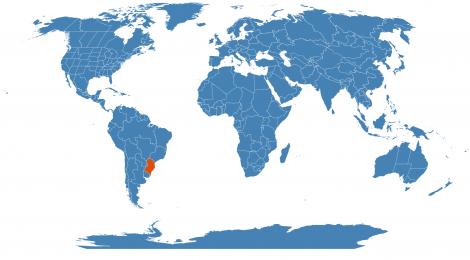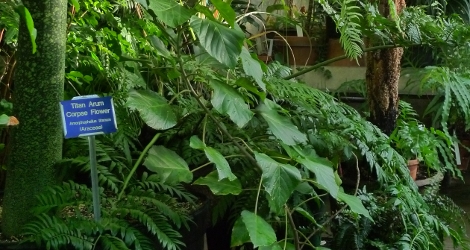Accession Data:
Dyckia brevifolia Baker
- Common Name:
- Family: Bromeliaceae Juss.
- Country of Origin: Brazil (Paraná to Santa Catarina) (endemic)

- Habitat: example of convergent evolution w/ Agave
- Description: stemless, herbaceous, rhizomatous perennials with thck, rigid, spiny leaves (about 30 when mature) in a rosette, central erect, outer recurved with lines of whitish scales; when fully mature, about 8 inches long, 18 inches high; flowers yellow, many in a spike about 12 inches, shorter than the sharp pointed bracts.
- Culture: Dyckias should be grown like succulents - in bright light and well-drained soil. While they are drought-tolerant, they do like water, especially during summer months. In fact, one (D. brevifolia) grows on rocks that are submerged during the rainy season. They tend to develop huge root systems, so give them plenty of pot space, or, climate permitting, grow them in the ground.
- USDA Zone: 9a-11
Accession Data:
- Accession # 199900591
- Source: Tom Lemieux - UC Boulder (ex Smith BG 96
- Accession Date: 10-29-1999
- Bench: 2213 - XER:Sonoran-Baja Deserts
- Currently: active - healthy
- Qty: 2 confirmed on 05-20-2025
Classification:
- Division: Magnoliophyta
- Class: Liliopsida
- SubClass: commelinids
- Order: Poales
- SubOrder:
- Family: Bromeliaceae
- SubFamily: Pitcairnioideae
- Tribe:
- SubTribe:
Flowering Data:
This accession has been observed in bloom on:| Year | Jan | Feb | Mar | Apr | May | Jun | Jul | Aug | Sep | Oct | Nov | Dec | ||||||||||||||||||||||||||||||||||||||||
|---|---|---|---|---|---|---|---|---|---|---|---|---|---|---|---|---|---|---|---|---|---|---|---|---|---|---|---|---|---|---|---|---|---|---|---|---|---|---|---|---|---|---|---|---|---|---|---|---|---|---|---|---|
| 2025 | ||||||||||||||||||||||||||||||||||||||||||||||||||||
| 2024 | ||||||||||||||||||||||||||||||||||||||||||||||||||||
| 2023 | ||||||||||||||||||||||||||||||||||||||||||||||||||||
| 2022 | ||||||||||||||||||||||||||||||||||||||||||||||||||||
| 2021 | ||||||||||||||||||||||||||||||||||||||||||||||||||||
| 2020 | ||||||||||||||||||||||||||||||||||||||||||||||||||||
| 2019 | ||||||||||||||||||||||||||||||||||||||||||||||||||||
| 2018 | ||||||||||||||||||||||||||||||||||||||||||||||||||||
| 2017 | ||||||||||||||||||||||||||||||||||||||||||||||||||||
| 2016 | ||||||||||||||||||||||||||||||||||||||||||||||||||||
| 2015 | ||||||||||||||||||||||||||||||||||||||||||||||||||||
| 2014 | ||||||||||||||||||||||||||||||||||||||||||||||||||||
| 2013 | ||||||||||||||||||||||||||||||||||||||||||||||||||||
| 2012 | ||||||||||||||||||||||||||||||||||||||||||||||||||||
| 2011 | ||||||||||||||||||||||||||||||||||||||||||||||||||||
| 2010 | ||||||||||||||||||||||||||||||||||||||||||||||||||||
| 2009 | ||||||||||||||||||||||||||||||||||||||||||||||||||||
| 2008 | ||||||||||||||||||||||||||||||||||||||||||||||||||||
References (internal):
- EEB Greenhouse Holdings native to: Brazil South
References (external):
- Bromeliad Society of Southern Florida Website
- The Plant List (2013). Version 1.1. Accessed 23 May 2015.
- WCSP (2015). World Checklist of Selected Plant Families. Facilitated by the Royal Botanic Gardens, Kew. Accessed 23 May 2015
data regenerated on Tue, 20 May 2025 15:24:06 -0400 [bcm v4.0]
Images:

Additional images for this accession:
Click on thumbnails to enlargeCurrent Accessions in the Bromeliaceae
Subfamily Brochinioideae
Subfamily Bromelioideae
- Acanthostachys strobilacea


- Aechmea allenii

- Aechmea brevicollis


- Aechmea chantinii


- Aechmea fasciata


- Aechmea recurvata


- Ananas bracteatus `Striatus'

- Ananas comosus


- Billbergia distachia

- Billbergia lietzei


- Billbergia magnifica

- Billbergia nutans


- Billbergia porteana


- Billbergia pyramidalis



- Cryptanthus bivittatus


- Cryptanthus cf. seidelianus

- Neoregelia ampullacea

- Neoregelia carolinae


- Neoregelia cruenta

- Neoregelia lilliputiana

- Neoregelia spectabilis


- Neoregelia tigrina
- Neoregelia zonata

- Nidularium innocentii

- Nidularium microps

- Ochagavia carnea

- Portea petropolitana


Subfamily Hechtioideae
Subfamily Pitcairnioideae
- Deuterocohnia brevifolia


- Dyckia brevifolia


- Dyckia fosteriana

- Fosterella penduliflora

- Pitcairnia atrorubens


- Pitcairnia heterophylla


- Pitcairnia xanthocalyx

Subfamily Puyoideae
Subfamily Tillandsioideae
- Catopsis sp.

- Tillandsia albida

- Tillandsia albida

- Tillandsia baileyi

- Tillandsia brachycaulos

- Tillandsia bulbosa


- Tillandsia caerulea

- Tillandsia graomogolensis

- Tillandsia heteromorpha

- Tillandsia intermedia

- Tillandsia ionantha


- Tillandsia jonesii

- Tillandsia purpurea


- Tillandsia recurvata

- Tillandsia seleriana

- Tillandsia simulata

- Tillandsia simulata

- Tillandsia stellifera

- Tillandsia tectorum X paleacea
- Tillandsia tenuifolia Emerald Forest

- Tillandsia unidentified

- Tillandsia usneoides


- Tillandsia usneoides W/C


- Tillandsia usneoides W/C


- Tillandsia usneoides W/C


- Tillandsia xerographica


- Vriesea correia-araujoi

- Vriesea flammea

- Vriesea fosteriana

- Vriesea splendens

 = indicates flowering in past 14 days
= indicates flowering in past 14 days
 = images available for this accession
= images available for this accession
 = map available for this accession
= map available for this accession
 = accession added within past 90 days
= accession added within past 90 days

